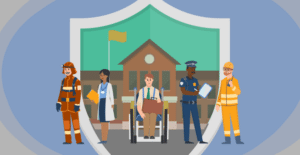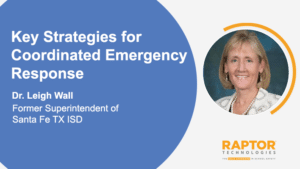Listen to this blog
4 minutes
“Keeping a child safe in our buildings is perhaps the most important responsibility,” Michael Reidenbach says.
Michael Reidenbach is the Executive Director of Security and Emergency Management of Charleston County School District (CCSD), the second-largest school system in South Carolina. He joined CCSD in 2013 after serving as a police officer and SRO. Michael is also a finalist for the 2022 Campus Safety Director of the Year award.
On a recent episode of School Safety Today, Michael shared how he keeps thousands of students and staff in his school communities safe every school day. A summary of the conversation is below. You can listen to the full episode here.
How Do School Resource Officers (SRO) Keep Students Safe?
“Number one, of course, is to protect the campus. [SROs are] also there to serve as informal counselors or mediators, helping students and staff work through issues hopefully before…it requires formal police intervention,” Michael shares. “Finally, [SROs] provide law-related education, which involves talking to students about the law enforcement profession.”
A successful SRO program relies heavily on building a strong community partnership. “Whether that’s with students, staff, or their families, it’s really fostering a positive relationship between the police officers and the community.” These relationships encourage students and guardians to share their concerns. This can ultimately help the district recognize struggling students and make sure they receive the right support before their situation escalates.
How Can Schools Prepare and Plan for Emergencies?
“Over the past couple of years, we undertook a significant project to completely rewrite our emergency operations plan (EOP),” Michael begins. “That process starts with conducting an assessment of…your threats and hazards to ensure that you have the plans and resources in place to address those.”
Schools should also consider what gaps they need to fill, and work with a multidisciplinary team—to get as many stakeholder perspectives as appropriate—to build the EOP. Training your staff is just as important. “You can have a plan, but if your [schools] don’t know what the plan is and they don’t know how to put it into action, then it doesn’t do you much good.”
How Can Schools Train Staff on the EOP?
“Educating [our students] is our primary mission, but if we don’t keep [them] safe, then everything else we do is for naught,” Michael explains. At CCSD, the team meets with staff on a regular basis to make sure they understand the EOP. CCSD also does two in-depth training sessions each year, as well as provide training options and material that principals can leverage at staff meetings. New school staff must also complete a safety briefing during their onboarding orientation.
Drills are another important aspect to prepare the entire school community for different emergencies. “We want to provide the training, but then also reinforce that training through the drills and exercises that we conduct throughout the year.”
The training and drills are not meant to scare, Michael notes. “We want [our school staff and students] to feel empowered by the preparation so that [they] actually feel more confident and less anxious about potential threats.”
How Does School Emergency Management Technology Help?
“We use technologies that will bring value and add to the safety of our campuses and increase the efficiency with which we can respond to emergencies.” These technologies include security cameras, two-way radios, and school emergency management tools.
Schools should consider whether their technology addresses multiple hazards. Some systems, he says, are too tailored to a specific threat. You’ll also want a system that you can integrate into your routines, such as when you practice drills. “You’re not going to be able to use [the system] effectively during an emergency if that’s the first time in a year you’ve touched it,” Michael warns.
Learn More Strategies
“We may solve today’s crisis and be successful, but we can’t take a victory lap. The work’s never done, we must keep on it and keep working together,” Michael says. Listen to the full School Safety Today episode to hear more best practices and lessons learned.
To learn more about Raptor and how we help protect every child, every school, every day, fill out this quick form to schedule a demo.
Related Resources
Guide to K-12 Emergency Management
Proven Strategies to Protect Your School.

Listen to this blog
4 minutes
Schedule a personalized demo
Featured video
Recent Webinar
Former Santa Fe Superintendent Shares Key Strategies for Coordinated Emergency Response
This is one of the most violent school years in...
Watch now






